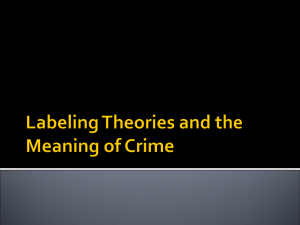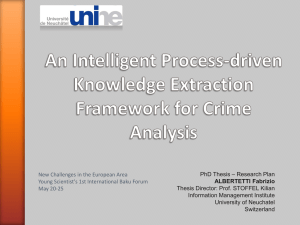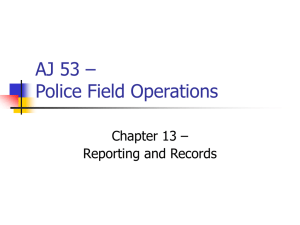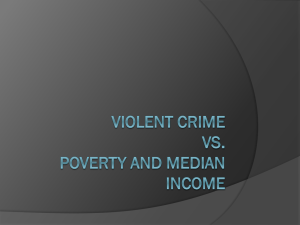Chapter 3: Theoretical Perspective on Race and Crime
advertisement
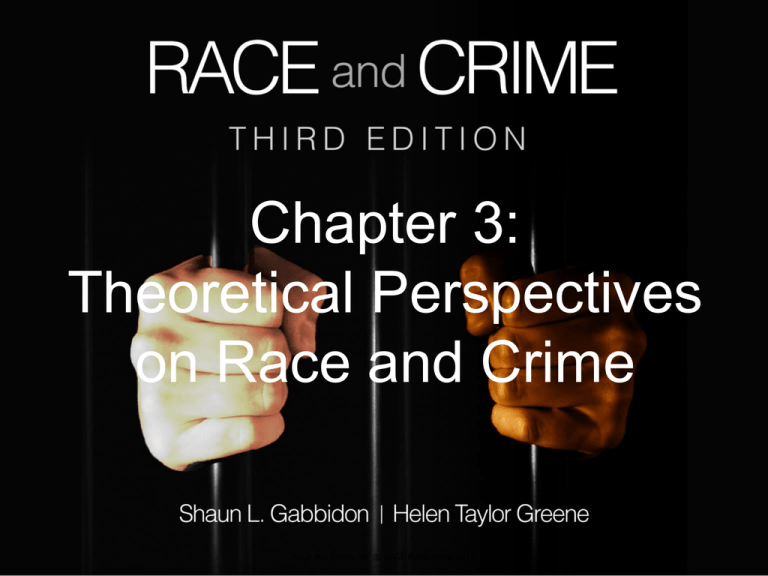
Chapter 3: Theoretical Perspectives on Race and Crime Race and Crime, 3e © SAGE Publications 2012 Theory What is theory? A theory is an explanation. Theory is a set of interconnected statements or propositions that explain how two or more events or factors are related to one another. Theories are categorized as macrotheories, microtheories or bridging theories. Macrotheories focus on the social structure and are generally not concerned with individual behavior Microtheories look to explain crime by looking at groups, but in small numbers, or at the individual level. Race and Crime, 3e © SAGE Publications 2012 Biology, Race, and Crime The linking of biology and crime is rooted in Europe. Phrenology, the study of the external shape of the head, was the first linkage of biology and crime. Italian criminologist and also referred to as the father of criminology, Cesare Lombroso felt race/ethnicity and crime were linked. Earnest A. Hooton’s two books Crime and the Man (1939) and The American Criminals (1939) also acknowledged race/ethnic differences in crime. Race and Crime, 3e © SAGE Publications 2012 Biology, Race, and Crime, cont. Crime and Human Nature (1985) Wilson and Herrnstein pointed to constitutional factors that may contribute to the overrepresentation of Blacks in crime. Wilson and Herrnstein suggested that Black males tend to be more mesomorphic (muscular) than White males. Higher scores on the MMPI (Minnesota Multiphasic Personality Inventory) than Whites, shows they are “less normal.” Another constitutional factor mentioned is low IQ. In 1980s conservatives latched onto the work of Wilson and Herrnstein. Critics argue that conservative thinkers have more interest in explaining crimes associated with racial minorities instead of those committed by middle- and upper-class whites. Why? Intelligence, Race, and Crime Due to the development and acceptance of intelligent tests a link between intelligence and crime was formed. Early literature suggested that criminals were of low intelligence. Henry H. Goddard one of the early IQ and crime theorists. Perspective was discredited and received little attention until 1970s. In the 1970s, Travis Hirschi and Michael J. Hindelang conducted a review of the literature on intelligence and crime. They concluded that race, crime, and intelligence were linked. Intelligence, Race, and Crime, cont. In 1994, Richard Herrnstein and Charles Murray published The The book was based on intellectual determinism (everything is linked to IQ). Bell Curve. Herrnstein and Murray suggested that low IQ contributed to the following: crime, poverty, illegitimacy, unemployment, and welfare dependency. Intelligence, Race, and Crime, cont. Herrnstein and Murray argued that low IQ results in school failure, which tends to lead to crime. They argued that low IQ leads to people being drawn to danger and having “an insensitivity to pain or social ostracism, and a host of derangements of various sorts”. The authors suggested that those with low IQs would have a hard time following ethical principles. Herrnstein and Murray noted that Blacks tended to have lower IQ's and were more likely to engage in criminality. Race and Crime, 3e © SAGE Publications 2012 Intelligence, Race, and Crime, cont. Limitations of the IQ and crime thesis: There still remain questions as to what IQ tests really measure. Moreover, there have always been questions of cultural and class biases with IQ tests. What explains the fact that persons with high IQs commit white-collar and political crime? Finally, there is also some uncertainty about whether differences in IQ are genetic or related to one’s environment. Race and Crime, 3e © SAGE Publications 2012 r/K Selection Theory r/K selection theory was created by Harvard biologist E. O. Wilson to explain population growth and decline in plants and animals. The theory has been adapted to humans by J. Philippe Rushton professor of psychology at Western Ontario University. It is a gene-based evolutionary theory that links many of the differences between the races, including crime patterns, to migrations out of Africa. Rushton believes that the migration patterns out of Africa explain the current positions of Blacks, Whites, and Asians. Race and Crime, 3e © SAGE Publications 2012 r/K Selection Theory, cont. At the heart of the r/K theory are reproduction, climate, and intelligence. Rushton’s theory relates to race and crime in that: aggression, impulsive behavior, low self-control, low intelligence, and lack of rule following are all associated with criminals and, who fall under the r-strategy, namely, Black people. Limitations: What explains White aggression across the globe? Ruston provides little emphasis on sociological factors. Very few “pure” races left. Race and Crime, 3e © SAGE Publications 2012 Wright’s Biosocial Thesis Biology and behavior has begun to become a more accepted area of study within criminology. Biological and social factors influence criminal behavior. Two reasons for race and problem behavior: Brain based functions in frontal, prefrontal, and orbital frontal cortex; abilities here are highly heritable and provide humans with their unique ability to plan, organize their lives and control their emotions (self-control and IQ also). Collective social behavior (CSB), neighborhoods with high CSB will tend to have lower crimes rates, while in many black neighborhoods (ghettos and inner cities) there is next to no CSB which results in higher crime rates. Wright’s Biosocial Thesis, cont. If his thesis was correct, shouldn’t all Black communities see this high crime rate and not just “many.” Although new area of study some findings have surfaced partially supporting biosocial assertions regarding the intersection of race, gender, behavior, and alleles. Race and Crime, 3e © SAGE Publications 2012 Sociological Disorganization W.E.B. Du Bois’s Philadelphia Negro study produced first urban ethnography. Du Bois’s thesis was that “Crime is a phenomenon of organized social life, and is the open rebellion of an individual against his social environment.” University of Chicago School of Sociology later started studying inner-city Chicago. Social disorganization (Shaw and McKay) and concentric zone perspective (Park and Burgess) dominated their approach. Race and Crime, 3e © SAGE Publications 2012 Sociological Disorganization, cont. Social disorganization refers to areas characterized by the following conditions: a. fluctuating populations, b. significant numbers of families on welfare, c. families renting, d. several ethnic groups in one area, e. high truancy rates, f. high infant mortality rates, g. high levels of unemployment, h. large numbers of condemned buildings, and i. a higher percentage of foreign-born and Negro heads of families. Race and Crime, 3e © SAGE Publications 2012 Sociological Disorganization, cont. Racial invariance thesis of Sampson and Wilson (1995) draws heavily on two of Wilson’s concepts from The Truly Disadvantaged (1987). The first, Concentration effects, speaks to the fact that Whites and Blacks live in considerably different areas. Social buffers (role models) show neighborhood kids that there are successful people who go to work, day in and day out. “Social isolation” or “the lack of contact or of sustained interaction with individuals and institutions that represent mainstream society” occurs when social buffers leave communities in large numbers. By not being exposed to mainstream individuals and institutions, socially isolated people tend to develop their own norms within these isolated areas. Sociological Disorganization, cont. Social disorganization has been applied to Native Americans. Research has shown that both social disorganization and poverty contribute to high levels of lethal violence in reservation communities. Female-headed households and ethnic heterogeneity are positively related to American Indian homicides. Other aspects of social disorganization (level of poverty and residential mobility) were not found to be important variables. Race and Crime, 3e © SAGE Publications 2012 Sociological Disorganization, cont. First, it impacts on the socioeconomic nature of the community. Second, since mass incarceration results in people leaving for prison then being released from prisons, it increases the mobility in certain communities. Finally, mass incarceration increases the heterogeneity of communities. Collective efficacy is defined as “social cohesion among neighbors combined with their willingness to intervene on the behalf of the common good.” In the communities where residents do not retreat behind their locked doors and actively look out for one another, there is a diminished likelihood that they will have many of the ills found in similar urban areas. Race and Crime, 3e © SAGE Publications 2012 Sociological Disorganization, cont. Both social disorganization and collective efficacy generally speak to high-crime urban areas. There have been several persistent criticisms of the theory. The ecological fallacy. The theory also does not explain how certain groups, such as Asians and Jewish communities, maintained low levels of crime and delinquency even though they lived in areas that might be categorized as socially disorganized. Race and Crime, 3e © SAGE Publications 2012 Culture Conflict Theory Originally formulated by criminologist Thorsten Sellin in the late 1930s. Culture conflict theory is heavily based on the work on Chicago School graduates Louis Wirth and Edwin Sutherland (who was to have collaborated with Sellin). Over a period of time, certain behavior becomes accepted within a culture (conduct norms). Powerful in society can control the definitions of conduct norms and what behaviors become crimes. Race and Crime, 3e © SAGE Publications 2012 Culture Conflict Theory, cont. Three ways conflicts between various cultural codes arise: a. when the codes clash on the border of contiguous cultural areas, b. when, as may be the case with legal norms, the law of one cultural group is extended to cover the territory of another, or c. when members of one cultural group migrate to another. The first type of culture conflict is called primary conflict or when foreign cultural practices clash with American cultural practices. Secondary conflicts are conflicts of norms which grow out of the evolution of cultures. Race and Crime, 3e © SAGE Publications 2012 Strain/Anomie Theory Robert K. Merton’s stain/anomie theory is one of the most cited criminological theories. Emile Durkheim used the term anomie to refer to a state of normlessness or lack of social regulation society. Based on the premise of all societies have: Culturally defined goal: “American Dream” (material wealth). Acceptable means of achieving it (education/work). Most people conform to goal and institutional means. Race and Crime, 3e © SAGE Publications 2012 Strain/Anomie Theory, cont. Others had their own “modes of adaptation”. Innovators Ritualism Retreatism Rebellion Merton noted the glass ceiling Blacks faced in America. Limitations of theory: Anomie theories have a middle-class bias. Does not explain white-collar and government crimes. Race and Crime, 3e © SAGE Publications 2012 General Strain Theory Robert Agnew wanted to specify Merton’s Anomie/Strain theory by approaching it in a micro aspect. He wanted to add the removal or loss of positive stimuli. Loss of a boyfriend/girlfriend, death of a family member, moving to a new school district, divorce, etc. Also the presentation of negative stimuli. Child abuse, neglect, criminal victimization, negative relations with peers or parents, etc. Race and Crime, 3e © SAGE Publications 2012 General Strain Theory, cont. Jang and Johnson found support for Agnew’s GST looking into African Americans and how the ones who were extremely religious committed less crime due to stronger support systems. Kaufman also found support for GST “a GST explanation of racial differences in offending…implies that African-Americans experience disproportionate strain in the social environment and/or have fewer resources for coping with strain in conventional ways.” Race and Crime, 3e © SAGE Publications 2012 Subcultural Theory Walter Miller’s (1958) theory stated lower-class residents adhered to the following “focal concerns”. Trouble: risk taking Toughness: fearless “handle themselves” Smartness: street smarts Excitement: pursuit of thrill seeking Fate: lives controlled by things they have no control over Autonomy: resent others having control over them Race and Crime, 3e © SAGE Publications 2012 Subcultural Theory, cont. Cloward and Ohlin (1960) suggested that when there are limited opportunities, youth join gangs with one of three orientations. criminal gangs: aim is to make money through a variety of illegitimate avenues “conflict” gang: engage in violent activities, doing whatever is necessary to maintain their status in the streets “retreatist” gangs: “double-failures” no success in either legitimate or illegitimate opportunities (turn to drug use) Race and Crime, 3e © SAGE Publications 2012 Subculture of Violence Theory The theory argues that within certain groups subcultures form that encourage or normalize violence. Members of the subculture are not violent all the time. Subculture is found in all age segments of society (emphasis on inner-city and minorities). It is found most in those in the late-adolescence to middleage categories. Those vested in subculture have no feelings of guilt toward their actions. Race and Crime, 3e © SAGE Publications 2012 Subculture of Violence Theory, cont. These are five major weaknesses of the theory: 1. There is an extreme emphasis on mentalistic value orientations of individuals. 2. The theory is questioned by some empirical findings. 3. The theory underemphasize a variety of structural, situational, and institutional variables which affect interpersonal violence. 4. Subcultural theory under emphasizes the effects of the law on patterns of criminal homicide. 5. There are other plausible economic, political, and social disadvantages of American Blacks that may produce high rates of homicide. Race and Crime, 3e © SAGE Publications 2012 Subculture of Violence Theory, cont. Hawkins’s (1983) alternative theory provided three propositions that were meant to address the holes in the subculture of violence theory. Proposition 1 states, “American Criminal Law: Black life is cheap but White life is valuable”. Proposition 2: “Past and present racial and social class differences in the administration of justice affect Black criminal violence”. Proposition 3: “economic deprivation creates a climate of powerlessness in which individual acts of violence are likely to take place”. Race and Crime, 3e © SAGE Publications 2012 The Code of the Streets “The Code of the Streets.” Theory formulated by Elijah Anderson, an urban ethnographer, published both a highly acclaimed article and book on topic. Theory focused on interpersonal violence in an impoverished Philadelphia neighborhood. At the heart of the code is the issue of respect— loosely defined as being treated ‘right,’ or granted deference one deserves. Being able to defend oneself is also an important part of the code. Race and Crime, 3e © SAGE Publications 2012 The Code of the Streets, cont. Theory talks about “Decent” and “Street” families. Decent families tend to accept mainstream values. Street families loosely supervise their children. Strict and teach their children to respect authority and act in a moral way. Not seriously tied to the code. Often unable to cope with them. These families believe in the code. Judge themselves and others according to its values. Criticisms of theory J. Miller (2001) believes that--prison, not the streets, is the more powerful contributor to the development of the code of the streets. Wacquant (2002) expresses concern about: The loose and over expansive definition of the “code of the streets”. There is considerable confusion as to the origins and vectors of the code of the streets. Conflict Theory Conflict theories focus on struggles between individuals and/or groups in terms of power differentials. Applying conflict theory to race and crime, one would look for discrimination in the following: Enforcement of laws Distribution of punishment W.E.B. Du Bois (1901) early conflict theorist (race and crime). Wrote about how states strategically enacted various laws (referred to as the “Black codes”) to control Black labor. Race and Crime, 3e © SAGE Publications 2012 Conflict Theory, cont. Felt that crime among Blacks was a symptom of the problem (White racism): “The Negro is not naturally criminal; he is usually patient and law-abiding. If slavery, the convict-lease system, the traffic in criminal labor, the lack of juvenile reformatories, together with the unfortunate discrimination and prejudice in other walks of life, have led to that sort of social protest and revolt we call crime, then we must look for remedy in the sane reform of these wrong social conditions, and not in intimidation, savagery, or legalized slavery of men.” -W.E.B. Du Bois (1901) The development of conflict theory over the last 40 years is often credited to the writings of: William Chambliss (1964, 1969) Austin Turk (1969) Richard Quinney (1970) Conflict Theory, cont. Much of these writings were class-based analyses that suggested the following were significant contributors to crime: capitalism class structure manipulation of laws Changing the structure of society was the answer to eliminating or reducing crime. According to Hawkins (1987) other considerations usually lacking in conflict theory: victim characteristics region accounting for race-appropriate behaviors Race and Crime, 3e © SAGE Publications 2012 The Colonial Model Colonialism traditionally refers to: the establishment of domination over a geographically external political unit, most of them inhabited by people of a different race and culture, where this domination is political and economic, and the colony exists subordinated and dependent on the mother country. Colonization also includes: Caste system based in racism Cultural imposition Cultural disintegration Cultural recreation Colonized being governed by representatives of the dominant power The Colonial Model, cont. All articulations of the theory note the important role of agents of the criminal justice system (police or military). The colonial model has applicability for racial groups who have been subjected to colonization. Native Americans African Americans Mexican Americans Limitations of theory: Two people can be exposed to the same oppression yet respond differently. The model is difficult to test. The model does not adequately address class issues. Race and Crime, 3e © SAGE Publications 2012 Integrated and Nontraditional on Race and Crime Structural-Cultural Theory William Oliver (1984) explored Black males and their “tough guy image” or, as he called it, the “Black compulsive masculinity alternative.” Oliver believes that Black males exhibit masculine behavior that places an overemphasis on: Toughness Sexual conquest Manipulation Thrill-seeking Race and Crime, 3e © SAGE Publications 2012 Integrated and Nontraditional on Race and Crime, cont. Oliver has argued that Black males act this way because of two reasons: First, to mitigate low self-esteem and negative feelings tied to being unable to “enact the traditional masculine role.” Second, those males who adapt the masculine approach pass it on to other males. Limitations of theory: Role of self-esteem has been questioned. Whites and other groups also adopt some of these same behaviors. Race and Crime, 3e © SAGE Publications 2012 Abortion, Race, and Crime John Donohue and Steven Levitt (2001) proposed that abortion had a role to play in crime dip of 1990s. More than 50% of the crime drop in the 1990s could be attributed to the 1973 Roe v. Wade Supreme Court decision that legalized abortion. They point to three important factors that support their thesis: 1. First, decline in crime coincided with the landmark decision and the period when those who would have been born would have reached their peak years of criminal activity. 2. Second, they suggested that the states that legalized abortion 3 years before the Roe v. Wade decision experienced earlier crime drops than the remaining states. 3. Finally, they pointed to the fact that states that have the highest abortion rates have also had the largest declines in crime. Abortion, Race, and Crime, cont. At the core of the theory are two premises: First, that abortion reduces the pool of individuals who would later engage in crime. Second, the theory relates to race and crime in that abortion is not random. Those likely to have abortions include: Unwed women Teenagers Blacks Limitations of theory: Not supported by replications in U.S. and Britain. Overstatement of role of abortion. Race and Crime, 3e © SAGE Publications 2012 Critical Race Theory Critical race theory (CRT) emanated from the critical legal studies movement during the 1970s. Closely aligns with radical criminology and represents another perspective that has proven useful for contextualizing race and crime. The perspective has two goals: The first is to understand how the law is used to maintain White supremacy and continue to oppress people of color. Second, countering or stopping the use of the law to maintain White supremacy. Race and Crime, 3e © SAGE Publications 2012 Critical Race Theory, cont. Critical race theorists have expressed concern about: Laws (e.g., three strikes you’re out) and practices (e.g., racial profiling, wrongful convictions) that directly impact on racial and ethnic minorities. Critical race theorists are also concerned about White privilege: This translates into an increased focus on “crimes in the streets,” as opposed to “crimes in the suites.” This focus criminalize the actions of other races and poor Whites, while minimizing or looking past the crimes of Whites in power. Race and Crime, 3e © SAGE Publications 2012 Conclusion Numerous theories have been applied to the question of race and crime. African Americans (and increasingly Latinos) remain the focal attention of theories related to race and crime. Which one best contextualizes race and crime? Biology Sociology Subcultural Social Control Colonial Conflict Traditional and nontraditional






